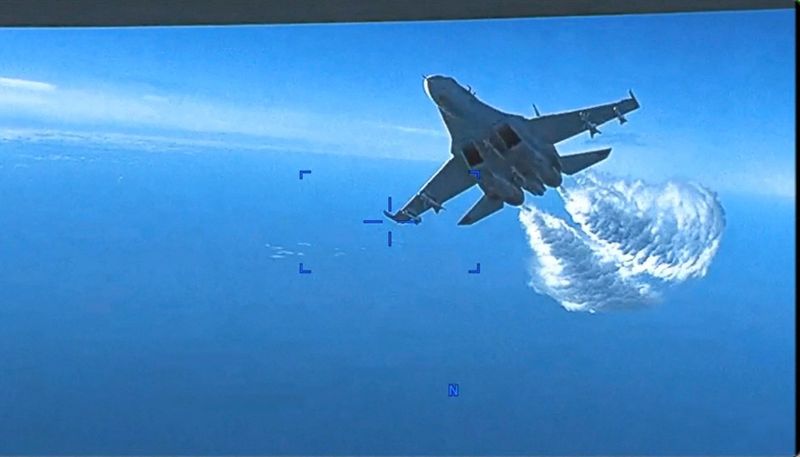By Phil Stewart and Idrees Ali
WASHINGTON (Reuters) - The United States on Thursday released a de-classified video showing Russia's intercept of a U.S. military surveillance drone downed over the Black Sea two days ago, images that the White House said exposed how Moscow was lying about what happened.
The downing of the U.S. MQ-9 drone on Tuesday was the first direct U.S.-Russian incident since the Ukraine war began, worsening already tense relations between Washington and Moscow as both countries publicly traded blame.
In the video, a Russian Su-27 fighter jet can be seen coming very close to the drone and dumping fuel near it, in what U.S. officials said was an apparent effort to damage the American aircraft as it flew.
It also shows the loss of the video feed after another close Russian maneuver, which the Pentagon said resulted from a Russian jet colliding with the drone. The video ends with images of the drone's damaged propeller, which the Pentagon said was caused by the collision, making the aircraft inoperable and leading it to crash into deep waters.
The Pentagon said the video, which is about 40 seconds long, was edited for length by the U.S. military but shows events in a sequential order.
A map provided by U.S. military showed the intercept first occurring between 40 and 50 nautical miles off Crimea, in international airspace. The collision took pace about 10 miles further and the drone eventually crashed 75 to 85 nautical miles from land, according to the U.S. military.
Russia has denied U.S. accusations that its jets acted recklessly, and instead has blamed "sharp maneuvering" by the drone for the crash. It says its jet did not make contact.
The White House said the footage released refuted Moscow's version of events.
"It absolutely just decimates the Russian lie about what they said happened or what they said didn't happen," White House spokesperson John Kirby told reporters. "It's pretty darn obvious when you look at that video that (the) fighter jet hit our drone."
The incident over international waters was a reminder of the risk of direct confrontation between the United States and Russia over Ukraine, which Moscow invaded more than a year ago and which Western allies have supported with intelligence and weapons.
A U.S. official, speaking on condition of anonymity, said Russian ships had been seen near the area where the drone crashed, though they did not appear to have recovered any parts of it yet.
Pentagon spokesperson Brigadier General Patrick Ryder said there were "indications" Moscow was trying to recover debris from the MQ-9.
"We assess it's very unlikely that they would be able to recover anything useful," Ryder told reporters, citing the depth of water and unspecified mitigation measures to guard against theft of any sensitive material on the drone.
The release of the video followed separate calls on Wednesday between the top U.S. general, Mark Milley, and his Russian counterpart, Chief of the General Staff Valery Gerasimov, as well as between U.S. Defense Secretary Lloyd Austin and his Russian counterpart, Sergei Shoigu.
In remarks to reporters on Wednesday, Milley said it was clear that the intercept and harassment of the drone was intentional, but it was unclear whether the Russian pilots meant to slam their aircraft into the drone-- a move that could also put themselves at risk.

Kirby said the incident was reckless and perhaps demonstrated Russian military incompetence.
"We don't know whether it was also intentional ... So I can't point to that video and say that this is a deliberate intent to escalate," he said.